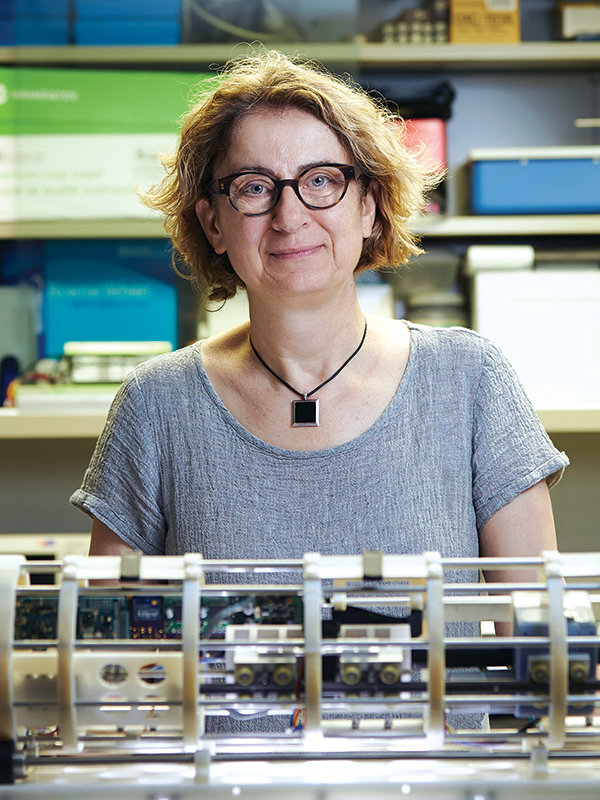A Creative Heartbeat
For the past 20 years, Maria Drangova, PhD’93, has followed her heart to opportunities that let her creativity run wild in the pursuit of bettering her community – both inside and outside the lab
By Jesica Hurst, BA’14
There is something innately satisfying about giving yourself the freedom to get messy, be creative and follow your heart when creating something new.
In all aspects of her life, Maria Drangova, PhD’93, has sought out these opportunities to let her creativity run wild in the pursuit of bettering her community. Whether it’s through her work in cardiovascular imaging as a scientist at Robarts Research Institute or her passion for pottery and the arts community as a whole, her desire for roles that embrace this creativity has allowed her to make change and impact many people’s lives for the better.
“There is just something about being creative – I can’t stop it, whether it’s science or art,” Drangova said. “I feel as though these two passions do cross over and impact one another, and creativity is the most common aspect between the two.”
“I feel as though these two passions do cross over and impact one another, and creativity is the most common aspect between the two.” —Maria Drangova, PhD’93
Drangova was born in Bulgaria and lived there throughout her childhood until she came to Canada for high school. Excelling in maths and sciences, Drangova enrolled in the University of Toronto’s Engineering Science program. Upon graduation she completed a Master of Medical Physics at McGill University and eventually found herself at Western University where she completed a PhD in Medical Biophysics.
After completing her PhD, the young scientist moved to California to complete a postdoctoral fellowship at Stanford University where she continued her focus on imaging. Soon after, she moved back to London to officially join the team at Robarts in 1997.
“I came back to Robarts to establish a research program in cardiac imaging and intervention, which built off of the skills I had acquired as a graduate student and fellow,” she said. “I was drawn to Robarts because of its diverse environment, which is fairly unique – I wanted the opportunity to work in an environment that had more than just one area of imaging.”
Drangova has spent the past 20 years building a lab at Robarts that focuses on cardiovascular imaging by developing techniques that have implications in basic research and clinical areas using computed tomography and magnetic resonance imaging. Her area of interest has always been imaging of the heart and vasculature, and on developing techniques to improve diagnosis of disease and ways of delivering better interventions of cardiovascular diseases.
In recent years, her lab has worked closely with electrophysiologists in the area of cardiovascular intervention. Treatment for cardiac electrophysiological diseases often involves radiofrequency ablation, which is performed using a catheter that is manoeuvred in the left atrium and requires tremendous expertise. While the treatment is effective in more than 60 per cent of patients, many need to have repeat procedures because the ablation of the tissues did not completely resolve the rhythm disorder.
The goal of Drangova’s team’s work is to use three-dimensional images of the patient’s heart to develop techniques that reduce procedure times and the requirement for repeat ablations. They are developing patient-specific devices and improving the guidance of the procedure through the use of imaging.
“It’s also very exciting that, because of these strong collaborations, we have had interesting developments where we have made improvements to the way the therapy is being delivered, even outside of imaging,” she said. “We are currently working on tools that help control the amount of force the interventionalists are applying to the tissue during the procedure, because there is currently no way to do this.”
Having a direct impact on clinical treatment is something Drangova has always strived for in her work. Having the ability to create innovative techniques and tools that can help individual patients – as well as the health care system as a whole – has been a main driving factor throughout her career.
“In research, we all want to create something or identify a method that could be used clinically,” she said, adding that many things that are developed do not move beyond the beginning stages of research because of the difficulty of translating it to the next stage. “I’m not going to count my chickens before they hatch, but our recent developments have the potential to make that sort of impact, which is something we are all very excited about.”
But aside from making a direct impact on clinical treatment, Drangova is also passionate about teaching, training and positively impacting the lives of the next generation of scientists.
“I’ve always tried to identify strengths in students and lead them to do the work that will be most impactful and valuable to them,” she said. “I’m constantly growing from learning with them and exploring new areas and ideas – it’s an excellent symbiotic relationship. They are the ones that have me most excited about the future of this research area.”









